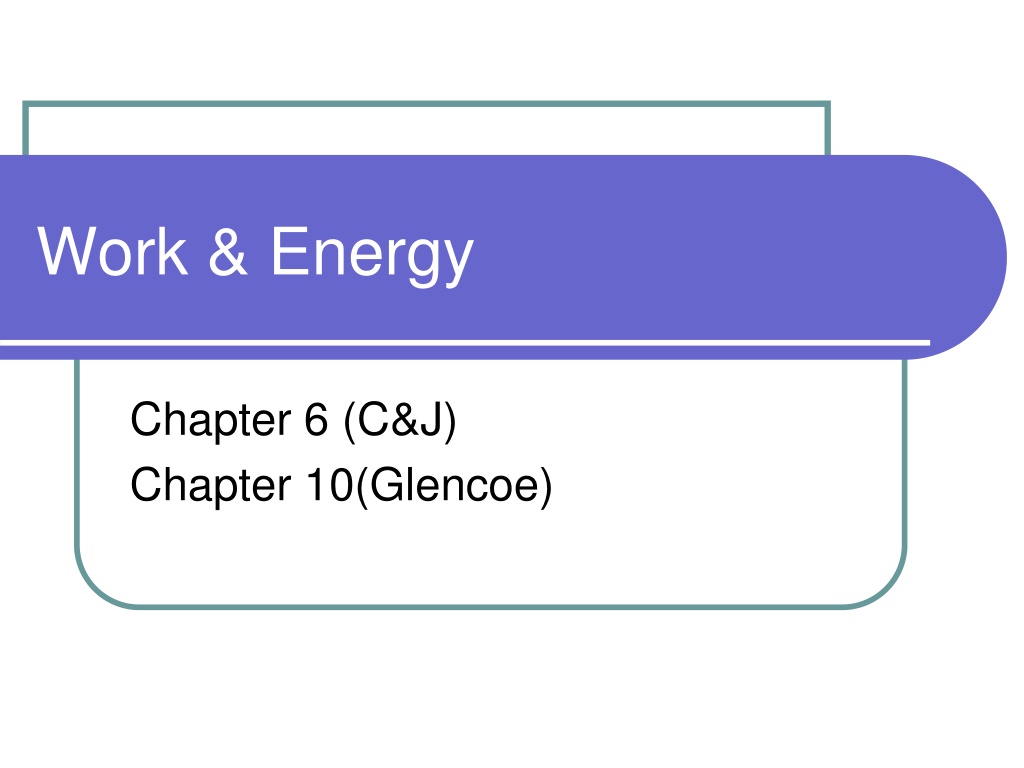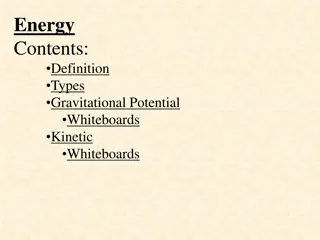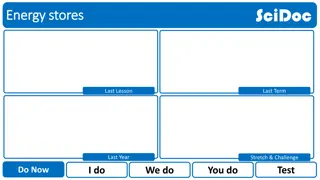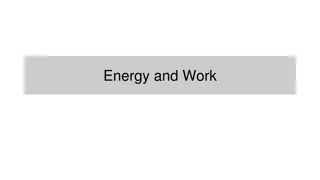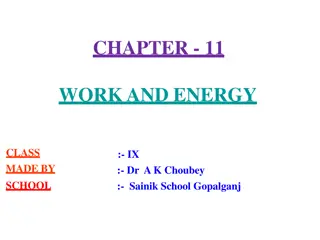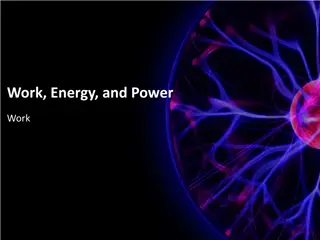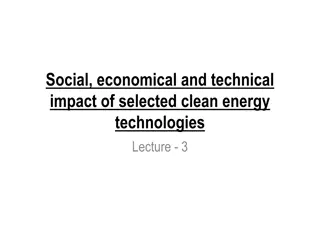Work & Energy
The fundamentals of work and energy, including different forms of energy, calculating work in varying scenarios, and practical examples to help you grasp the concepts effectively. Discover the connection between force, displacement, and work, as well as the significance of energy in various physical systems.
Download Presentation

Please find below an Image/Link to download the presentation.
The content on the website is provided AS IS for your information and personal use only. It may not be sold, licensed, or shared on other websites without obtaining consent from the author.If you encounter any issues during the download, it is possible that the publisher has removed the file from their server.
You are allowed to download the files provided on this website for personal or commercial use, subject to the condition that they are used lawfully. All files are the property of their respective owners.
The content on the website is provided AS IS for your information and personal use only. It may not be sold, licensed, or shared on other websites without obtaining consent from the author.
E N D
Presentation Transcript
Work & Energy Chapter 6 (C&J) Chapter 10(Glencoe)
Energy What is energy? The capacity of a physical system to do work. What are some forms of energy? Kinetic Energy Potential Energy Gravitational Potential Energy (gravity) Elastic Potential Energy (springs, rubber bands) Chemical Energy (chemical bonds) Rest Mass Energy = Nuclear (E = mc2) Electric Potential Energy ( U = kq1q2/r) Thermal Energy (heat = KE of molecules) Sound (waves) Light (waves/photons)
Work What is work? Work is the application of a force to an object that causes it to move some displacement (?). ? = ?? Note: Work is a scalar quantity, i.e. it has magnitude, but no direction. ? d If Bob, the warehouse worker pushes the crate with a horizontal force of 50 newtons and causes it to go through a 10 meter displacement, how much work has he done?
Calculating Work What if the force is not completely in the same direction as the displacement of the object? F
Calculating Work When all the force is not in the same direction as the displacement of the object, we can use simple trig (Component Vector Resolution) to determine the magnitude of the force in the direction of interest. Hence: ? = ?????? The angle for the vertical component of force relative to the direction of motion is 90 degrees. (????? = ?) ? ??= ????? d ??= ????? NOTE: Only the component of the force that acts in the direction of motion does work on the object.
Example #1: Little Johnny pulls his loaded wagon 30 meters across a level playground in 1 minute while applying a constant force of 75 Newtons. How much work has he done? The angle between the handle of the wagon and the direction of motion is 40 . F d
Example #1: Formula: ? = ?????? Known: Displacement: 30 m Force 75 N = 40 Time = 1 minute Solve: ? = (75?)(30?)cos40 = 1,724 ?
Example #2: The moon revolves around the Earth approximately once every 29.5 days. How much work is done by the gravitational force? GmmmE r2 F = (6.67x10-11Nm2/kg2)(7.35x1022kg)(5.98x1024kg) (3.84x108m)2 F = F = 1.99x1020N In one lunar month, the moon will travel 2 rE-m d = 2 (3.84x108m) = 2.41x109m
Example #2: HOWEVER!! ? = ?????? Since: is 90 , Fcos = 0 While distance is large, displacement is 0, and ?? = 0 Hence: ? = 0 d F
Kinetic Energy What is Kinetic Energy? The energy of motion. ?? = ??? If you double the mass, what happens to the kinetic energy? If you double the speed, what happens to the kinetic energy? If you triple the speed, what happens to the kinetic energy? It increases by a factor of 9! It doubles. It quadruples.
Kinetic Energy & Work Newton s 2nd Law of Motion (????= ??) ??2 ??2= 2?? Fnet Substituting for a: m 2???? ??2 ??2= ? ? Multiplying both sides of the equation by m ???2 ???2= ?????
Kinetic Energy & Work The left side of the mathematical relationship is equal to the change in Kinetic Energy of the system. ?? = ???2 ???2 The right side of the mathematical relationship is equal to the amount of net Work done by the environment on the system. ? = ?????
Work Energy Theorem The Work-Energy Theorem states that the work done on an object is equal to its change in kinetic energy. ?? = ? Units: Joule (J) 1 Joule is equal to the amount of work done by a 1 Newton force over a displacement of 1 meter. 1 Nm 1 kg m2/s2
Work-Energy Theorem: Example #3 The Iowa class battleship built during World War II has 9 16-inch guns. The length of the gun is 20 meters long. They can fire a 1,900 lb projectile (862 kg). The muzzle velocity (speed at which the projectile leaves the gun) is 1,830 mph, or 820 m/s! That is more than twice the speed of sound! How much work was done on the projectile to launch it? What was the average net force acting on the projectile?
Work-Energy Theorem: Example #3 (Cont.) How much work was done on the projectile to launch it? Use the Work-Energy Theorem: ? = ?? = ??? ???=1 2 1 2 2??? 2??? Since vi = 0, ? = ???=1 2 2??? ? =1 2(862??)(820? ? = 2.90 108? ?)2
Work-Energy Theorem: Example #3 (Cont.) What was the average net force acting on the projectile? ? = ? ? ? =? ? ? =2.90 108? 20? ? = 1.45 107? That s 3.26 x 106 pounds of force! Or over 1600 tons of force!
Work and Friction: Example #4 The crate below is pushed at a constant speed across the floor through a displacement of 10m with a 50N force. How much work is done by the worker? How much work is done by friction? What is the net work done? 1. 2. 3. ?? ? d = 10 m
Example #4 (cont.): 1. ???????= ?? = (50?)(10?) = 500? 2. ?????????= ?? = ( 50?)(10?) = 500? 3. If we add these two results together, we arrive at 0J of work done on the system by all the external forces acting on it. Alternatively, since the speed is constant, we know that there is no net force on the system. Since ????= 0, ? = ???? ? = 0 Similarly, since the speed does not change: Using the work-energy theorem we find that: ? = ?? = ???2 ???2= 0.
Gravitational Potential Energy If kinetic energy is the energy of motion, what is gravitational potential energy? Stored energy with the potential to do work as a result of the Earth s gravitational attraction and the object s position. For example: A ball sitting on a table has gravitational potential energy due to its position. When it rolls off the edge, it falls such that its weight provides an unbalanced force over a vertical displacement. Hence, work is done by gravity.
Gravitational Potential Energy Gravitational Potential Energy ?? = ?? Work By substituting ?? for ??, we obtain: ?? = ?? h Note: For objects close to the surface of the Earth: 1. g is constant. 2. Air resistance can be ignored.
Example 5: A 60 kg skier is at the top of a slope. By the time the skier gets to the lift at the bottom of the slope, she has traveled 100 m in the vertical direction. If the gravitational potential energy at the bottom hill is zero, what is her gravitational potential energy at what is her gravitational potential energy at the top of the hill the top of the hill? If the gravitational potential energy at the top is set to zero, what is her gravitational potential energy what is her gravitational potential energy at the bottom of the hill at the bottom of the hill? bottom of the 1. top of the hill 2.
Case 1 ?? = ?? ? = 60 ?? ? = 9.81? ?2 = 100 ? 9.81? A 100 ? ?? = 60 ?? ?2 ?? = 59000 ? ?? = 59 ?? h = 100m B
Case 2 ?? = ?? ? = 60 ?? ? = 9.81? ?2 = 100 ? 9.81? 100 ? B ?? = 60 ?? ?2 ?? = 59000 ? ?? = 59 ?? h = 100m A
Power What is it? Power is measure of the amount of work done per unit of time. ? = ?/? What are the units? Joule/second Watts
Example 6: Recalling Johnny in Ex. 1 pulling the wagon across the school yard. He expended 1,724 Joules of energy over a period of one minute. What was his power output? ? = ?/? ? = 1724?/60? ? = 28.7 ?
Alternate representations for Power As previously discussed: Power = Work / Time Alternatively: ? = ? ?/? Since d/t = velocity ? = ? ? In this case here, we are talking about an average force and an average velocity.
Example 7: A corvette has an aerodynamic drag coefficient of 0.33, which translates to about 520 N (117 lbs) of air resistance at 26.8 m/s (60 mph). In addition to this frictional force, the friction due to the tires is about 213.5 N (48 lbs). Determine the power output of the vehicle at this speed.
Example 7 (cont.) The total force of friction that has to be overcome is a sum of all the external frictional forces acting on the vehicle. Ff = Fair drag + Ftire resistance Ff = 520N + 213.5N = 733.5N ? = ? ? P = (733.5N)(26.8 m/s) = 19,657.8 W P = 26.4 hp If an engine has an output of 350 hp, what is the extra 323.6 horsepower needed for? Acceleration Plus, at higher speeds the resistive forces due to air and tire friction increase.
Key Ideas Energy of motion is Kinetic Energy = mv2. Work = The amount of energy required to move an object from one location to another. The Work-Energy Theorem states that the change in kinetic energy of a system is equal to the amount of work done by the environment on that system. Power is a measure of the amount of work done per unit of time.
